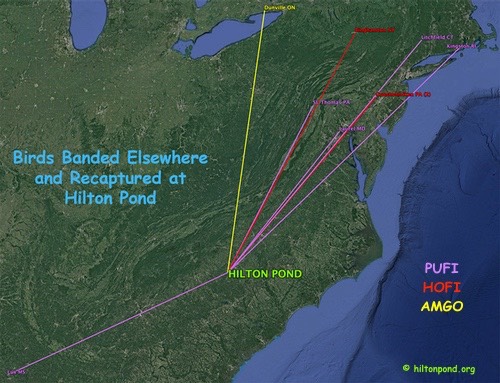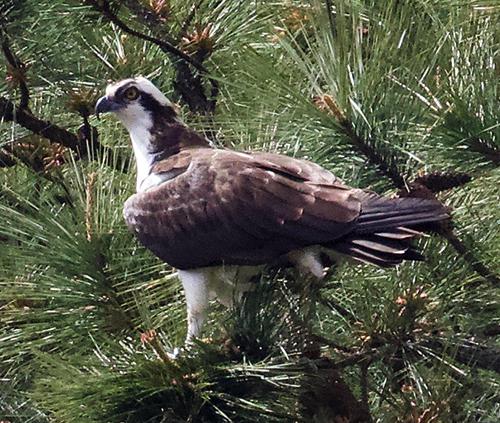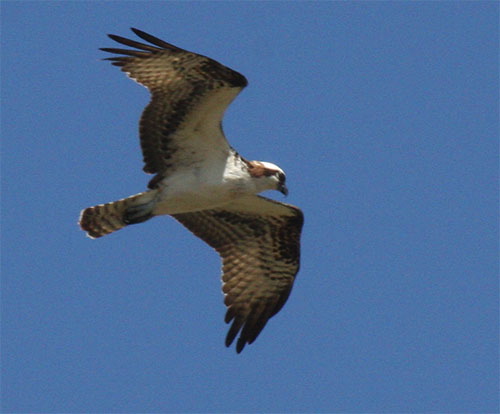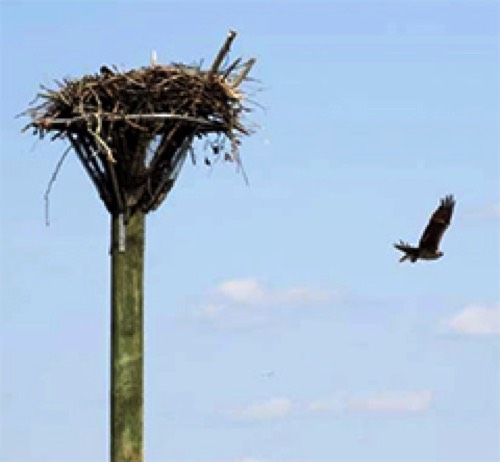- Established 1982 -HOME: www.hiltonpond.org
THIS WEEK at HILTON POND Subscribe for free to our award-winning nature newsletter (Back to Preceding Week; on to Next Week) |
A PURPLE FINCH AND We've posted a lot about Purple Finches in recent weeks, in part because for a while at Hilton Pond Center we were overwhelmed by them. As February ended, their numbers dropped dramatically--from the 297 banded in 2019 to zero PUFI coming to our feeders. After that abrupt disappearance Purple Finches trickled back in again, with another 51 banded in March. This month we've even recaptured a few "old" PUFI we banded in previous winters, including a 6th-year female first handled in Jan 2015. We frequently re-trap finches the same day or week we band them, so back on 18 March we weren't all that surprised to see an already-banded brown Purple Finch in a trap with some unbanded ones. (The bird in question is pictured below; note the shiny, relatively new band on its right leg.)
All text, maps, charts & photos © Hilton Pond Center Upon removing this banded bird from the trap, we carefully checked the number to see when it had been banded. Its aluminum band read: 2521-54988, which didn't ring a bell. Hmmm. Our current series has a prefix of 2821, with the series 49xxx, so we were immediately suspicious and consulted the Center's banding archives. Hmmm, again. We found no record of a 2521 prefix, and no 54xxx series in our files back to when we started in 1982. For the third time, Hmmm. You might guess what all this had to mean: We had just caught a new Purple Finch banded elsewhere by somebody else! Such happenings are cause for great jubilation for any bird bander because they are relatively rare--especially in the case of our banding operations at Hilton Pond. Our last similar encounter was in 2004, and in 38 years of work only nine times have we caught another bander's bird--five Purple Finches, three House Finches, and an American Goldfinch. Needless to say, we were jubilant and quickly went to the U.S. Bird Banding Laboratory's on-line form for reporting banded birds. After keying in our contact info, plus date, location, and recapture band number, we anxiously clicked the "SEND" button and--voila!--the BBL Web site instantly returned the following: "Purple Finch #2521-54988 was banded as a hatch-year bird of unknown sex on 18 October 2018 by associates of Dr. Peter W. Paton near . . . Kingston, Rhode Island!" Wowzer! Dr. Paton's PUFI was first caught last fall--probably near where it hatched--by a team led by resident master bander Julie Shieldcastle. After that the 25g ball of fluff flew south for at least 692 air miles before stopping for sunflower seeds at Hilton Pond. This encounter was the furthest we've had someone's banded bird travel before being recaptured at the Center. What an amazing trip and encounter! (We hope you're as excited as we.) This well-traveled bird may continue to visit our feeders--perhaps avoiding those hanging traps--but very soon will turn around for a return trip to Rhode Island, or beyond. Assuming this far-flying Purple Finch navigates safely back home, it would be quite fulfilling for it to show up on the other end of its migratory path and be captured once again by Dr. Paton in Rhode Island. What are the odds? Stay tuned! All text, maps, charts & photos © Hilton Pond Center (Click on map above for a larger version in a new browser window) Now that you've seen our excitement over capturing a banded Purple Finch from Rhode Island, we thought you'd be interested in learning about those other eight banded finches we've recaptured at Hilton Pond. The map above corresponds with the data on the table below. (PUFI = Purple Finch; HOFI = House Finch; AMGO = American Goldfinch)
All text, maps, charts & photos © Hilton Pond Center With the exception of the Ontario goldfinch and that oddball Purple Finch banded in Mississippi, migrant finches that showed up at Hilton Pond came from a relatively narrow region of the northeastern U.S. (see map), east of the Appalachians. This could suggest PUFI and HOFI that breed across the Midwest and southern Canada spend the winter in some other region than the Carolina Piedmont. (An analysis of banding recovery and recapture data on file with the Bird Banding Lab might provide further insight. At some point we may request those public domain data--available to anyone with good reason to inquire.) Our chart above reveals that all three House Finches recaptured at the Center were banded and then showed up here in the early 1980s; although northeastern HOFI were highly migratory during that period, in more recent years this species seems to have adapted to colder weather and perhaps has given up on flying south. (NOTE 1: Not coincidentally, House Finches banded at Hilton Pond no longer are being reported by other banders north of here. NOTE 2: Western U.S. populations of HOFI--sometimes called "Hollywood Finches"--do not seem to undertake long-distance migration.) All text, maps, charts & photos © Hilton Pond Center (Click on image above for a more legible version in a new browser window) Other comments: 1) Two of those three House Finches recaptured at Hilton Pond were originally handled near Philadelphia by a bander named--no kidding--Dr. Pepper; All text, maps, charts & photos © Hilton Pond Center
While observing this gluttony our peripheral vision detected something large, so we twisted to get a surprising view of an Osprey sailing across Hilton Pond. The bird eventually landed in a tall pine tree on the far bank; there it sat for a couple of minutes--likely surveying the impoundment for potential prey. Suddenly the big bird--we believe a nearly six-foot wingspan does qualify as "big"--swooped from its perch, slammed the surface of the water with both feet, and came up with a Largemouth Bass that had to be at least 15" long. The Osprey labored to gain altitude, cutting big circles around the pond perimeter before sailing over the tops of the trees, heading northwest with supper tightly clenched in its talons. This is only the fifth Osprey sighting at Hilton Pond Center in 38 years--all in March or early April as these fish hawks apparently were migrating from wintering grounds as far away as South America. This one may end up in Alaska or one of the Canadian provinces, although the species breeds in ever greater numbers on inland lakes in the Carolinas.
All text, maps, charts & photos © Hilton Pond Center Curiously, the tree this year's bird perched in at the Center was the same pine where we observed and photographed one a few years ago (see our file photo above). Might this be the same Osprey, following precisely the same northbound flight path and making the same exact stops year after year? We'll never know, of course, but knowing many birds' uncanny site fidelity it wouldn't be a surprise and is certainly something to ponder.
All text, maps, charts & photos © Hilton Pond Center After that sighting of an Osprey on 24 March, the next evening we were gazing out the office window--we do that a LOT--and again saw a large soaring bird with wings held in the shape of a "W" (above). Lo and behold, another--or the same--Osprey stooped and landed gracefully in the same Loblolly Pine where it, or another, had perched the day before--AND a few years back.
All text, maps, charts & photos © Hilton Pond Center One thing that's a bit quizzical: Hilton Pond is a very small one-acre impoundment, and there's another pond just downstream partly on the property that's at least thrice its size. Not too far beyond sits a pond that's bigger still, and to the east are even broader ones--lake size, even. What is it about our small pond that seems so attractive to Ospreys? We dunno. Under gray skies and waning light over a distance of 150 yards we took a photo (just above) of the second bird on 25 March, so the image isn't all that sharp. Even so, you can see the Osprey's yellow iris and heavily decurved bill, the latter nicely adapted for eviscerating whatever prey a fish hawk might capture. We're guessing our two most recent sightings were the same Osprey, but maybe not. (Based on differences in head plumage we doubt the Ospreys in the two photos above from years apart are one and the same. But who knows?)
All text, maps, charts & photos © Hilton Pond Center
Checks also can be sent to Hilton Pond Center at: All contributions are tax-deductible on your Don't forget to scroll down for Nature Notes & Photos, |
|---|
|
"This Week at Hilton Pond" is written and photographed by Bill Hilton Jr., executive director of Hilton Pond Center for Piedmont Natural History
|
|
|
Please refer "This Week at Hilton Pond" to others by clicking on this button: |
|




 and 2) We are most pleased to know we recaptured a Purple Finch banded in Maryland by Dr. Chandler Robbins
and 2) We are most pleased to know we recaptured a Purple Finch banded in Maryland by Dr. Chandler Robbins  On the 24th of this month we started to watch a March Madness basketball game but came to our senses and retired instead to our office space for a more relaxing look at birds. We instead encountered the usual late afternoon feeding frenzy, with lots of seeds rapidly going down gullets of hyperactive Northern Cardinals, House Finches, Carolina Chickadees, and a couple of Brown-headed Nuthatches.
On the 24th of this month we started to watch a March Madness basketball game but came to our senses and retired instead to our office space for a more relaxing look at birds. We instead encountered the usual late afternoon feeding frenzy, with lots of seeds rapidly going down gullets of hyperactive Northern Cardinals, House Finches, Carolina Chickadees, and a couple of Brown-headed Nuthatches. 


 Alas, we did not get to see the most recent Osprey at work on the 25th; wife Susan made the supper call--ironically, a wonderful repast of baked flounder--and when we returned with full belly the Osprey had flown, perhaps with its own fishy meal. If we see it again anytime soon we may go to the effort of putting up a nest pole to see if an Osprey will stay. This strategy works on big ol' Lake Wylie nearby
Alas, we did not get to see the most recent Osprey at work on the 25th; wife Susan made the supper call--ironically, a wonderful repast of baked flounder--and when we returned with full belly the Osprey had flown, perhaps with its own fishy meal. If we see it again anytime soon we may go to the effort of putting up a nest pole to see if an Osprey will stay. This strategy works on big ol' Lake Wylie nearby 









 Oct 15 to Mar 15:
Oct 15 to Mar 15: Please report your
Please report your